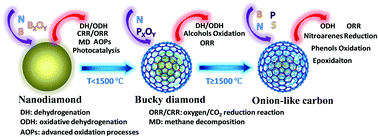Catalysis by hybrid sp2/sp3 nanodiamonds and their role in the design of advanced nanocarbon materials
Abstract
Hybrid sp2/sp3 nanocarbons, in particular sp3-hybridized ultra-dispersed nanodiamonds and derivative materials, such as the sp3/sp2-hybridized bucky nanodiamonds and sp2-hybridized onion-like carbons, represent a rather interesting class of catalysts still under consideration. Their characteristics, properties and catalytic reactivity are presented, with an analysis of the state-of-the-art of their use in gas- and liquid-phase reactions, including photo- and electro-catalysis. It is remarked that intrinsic differences exist between these and other nanostructured carbon catalysts. The analysis shows how different features make nanocarbons unique with respect to other types of catalysts and are the bases for an advanced design of nanocarbon-type catalysts. The aspects discussed regard the presence of hybrid sp2/sp3 configurations, nano-engineering related to the role of defects and vacancies in their catalytic behaviour, the creation of active sites by modification in the charge density at carbon atoms or C–C bonds, the generation of strained C–C bonds by curvature and other mechanisms, and the formation of semiconducting areas and defect sites at the interface with supported nanoparticles. The advanced strategies for identifying and quantifying active sites of carbon catalysts are highlighted.

- This article is part of the themed collection: New catalytic materials for energy and chemistry in transition


 Please wait while we load your content...
Please wait while we load your content...